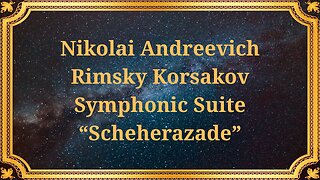Premium Only Content

Ludwig van Beethoven Violin Sonata №3 in E Flat major, Op 12 №3
#Beethoven #ClassicalMusic #ViolinSonata #EFlatMajor #Op12no3 #MusicAppreciation #SonataForm #MusicHistory #Composer #RomanticEra
Wolfgang Schneiderhan, Wilhelm Kempff
Ludwig van Beethoven, a towering figure in the realm of classical music, revolutionized the world of composition with his groundbreaking works. Among these masterpieces, the Violin Sonata No. 3 in E Flat Major, Op 12 No. 3, stands as a testament to Beethoven's genius and innovation.
Beethoven composed the Violin Sonata No. 3 in E Flat Major, Op 12 No. 3, during the early years of his career, around 1798-1799. This period marked a transition from the Classical to the Romantic era, and Beethoven's works played a crucial role in paving the way for the musical developments of the time. The sonata exemplifies Beethoven's departure from the conventions of the Classical period and foreshadows the daring and dramatic characteristics that would define his later compositions.
The Violin Sonata No. 3 follows the traditional three-movement structure commonly found in sonatas of the time. The first movement, marked Allegro con spirito, introduces a spirited and lively theme, showcasing Beethoven's ability to captivate the listener from the very beginning. The second movement, marked Adagio con molt'espressione, contrasts the energetic first movement with a serene and introspective atmosphere. The final movement, marked Rondo: Allegro molto, brings the sonata to a thrilling conclusion with its playful and virtuosic passages.
Beethoven's Violin Sonata No. 3 exhibits several innovative and expressive elements that distinguish it from the works of his predecessors. The composition showcases Beethoven's penchant for exploring emotional depth and intensity. It showcases his mastery of dynamic contrasts, utilizing sudden shifts from delicate pianissimo to thunderous fortissimo passages. Beethoven's use of unexpected harmonies, daring modulations, and intricate polyphonic textures further contribute to the sonata's captivating and expressive nature.
The Violin Sonata No. 3 highlights the importance of equal partnership between the violin and piano. Unlike earlier sonatas where the piano often took a dominant role, Beethoven gives the violin an equal voice in this composition. Both instruments engage in a musical dialogue, intertwining their melodies and harmonies to create a harmonious and balanced whole.
Beethoven's Violin Sonata No. 3 in E Flat Major, Op 12 No. 3, continues to captivate audiences with its timeless beauty and emotional depth. Its innovative and expressive qualities resonate with listeners, showcasing Beethoven's visionary approach to composition. The sonata's enduring appeal lies in its ability to evoke a wide range of emotions, from joy to introspection, leaving a lasting impression on all who experience it.
Conclusion:
Ludwig van Beethoven's Violin Sonata No. 3 in E Flat Major, Op 12 No. 3, is a testament to the composer's artistic brilliance and his profound impact on the evolution of classical music. Its innovative structure, expressive elements, and collaborative nature make it a cherished gem of the violin and piano repertoire. This composition stands as a testament to Beethoven's enduring legacy, reminding us of his unparalleled contributions to the world of music.
You have the opportunity to support the channel:
https://destream.net/live/RadSiarAl/donate
https://www.buymeacoffee.com/6355radsiaral
-
 41:38
41:38
Classical music_Music Inspiration
1 month agoNikolai Andreevich Rimsky Korsakov Symphonic Suite “Scheherazade”
1491 -
 7:51
7:51
scoutthedoggie
2 hours agoAirsoft War Scotland - The Stargate Attack
952 -
 16:09
16:09
Silver Dragons
1 day agoThese BROKEN Silver & Gold Coins BLEW ME AWAY - CSOA EP. 1
3K6 -
 11:25
11:25
Damon Imani
1 day ago11 Minutes of Damon DESTROYING The View Hosts | Compilation Vol.15
1.61K3 -
 LIVE
LIVE
FusedAegisTV
14 hours agoOFFICIAL Evo 2025 Day 3 Co-Stream - Las Vegas, NV ∥ Top 8 FINALS! SF6, Tekken 8 & MORE
2,095 watching -
 LIVE
LIVE
itsReel
1 hour agoHAPPY SUNDAY! Picture Perfect, Then Tigger Happy!
53 watching -
 17:28
17:28
Degenerate Jay
3 days ago $0.12 earnedDoes Batman: Arkham Asylum Need A Remake?
1.88K -
 LIVE
LIVE
C03Games
43 minutes agoLiving The Mob Life Ain't Easy (Mafia II)
49 watching -
 5:50
5:50
VSOGunChannel
1 day ago $0.14 earnedMcCloskey Finally Gets His Rifle Back
1.54K5 -
 1:01:07
1:01:07
Professor Gerdes Explains 🇺🇦
22 hours agoWhat is Happening With Trump and Putin RIGHT NOW?
1.74K2